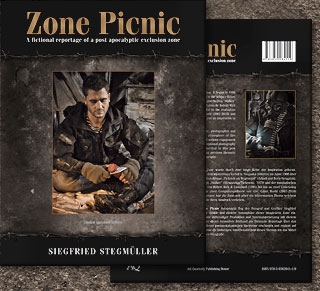

|
|

Not only the Zone is of constant
unexpected changes but so is life. |
The 1st edition of the ZONE PICNIC book was printed in March 2010 as a limited signature edition (500 numbered pieces). The books were packed and ready for sale when a random check showed that the production quality of the finished book did not come up to the artist's expectations.
It was then decided not to release this book mainly because of the inadequate book binding which would not have met the otherwise extremely high quality of production. A second attempt or a variation on the original concept may follow. |

 |
Ever since its origin, the concept of the Zone has continued to inspire creators of all genres of art. However, a description of the Zone itself and the effect it has can only be an approximate portrayal of what it is; just as the Zone itself is subjected to constant change, so too is every attempt to describe it. In contrast to the scenario frequently used in many narratives of a world-encompassing, post-apocalyptic portrayal of survival, this zone is a life-threatening island surrounded by the normal world. Due to the potential dangers that are contained within this region and which could emanate from it, the Zone is placed under military guard and declared an exclusion zone for the whole of the human race.
In the original description by the author duo Arkadi and Boris Strugatsky, there are several zones whose origins are left to speculation. One surmises that they were formed by the impact of a meteor or were created by extraterrestrial intelligence; Stanislaw Lem has interesting thoughts on this in the afterword of the Russian science fiction novel Roadside Picnic. A further description places a single zone in the area surrounding Chernobyl with the nuclear power plant at its centre. The long-term radioactive contamination resulting from the “worst case scenario” meltdown in 1986 created a natural exclusion zone where some scientists were able to pursue their unauthorised and disputable experiments without the knowledge or permission of the community. By failing in their plans and consequently no longer in control of their own experiments, they themselves have shaped the Zone with all of its anomalies and mutations.
In the Zone, physical laws known to human beings intermix with new, unknown phenomena. It is in the nature of human curiosity, above all that of scientists, to be drawn towards the inexplicable and driven to recklessly infiltrate and stay in the Zone to retrieve valuable artifacts and gain new insights in the occurring anomalies and mutations. In pure desperation, some of the more venturesome feel it is their fate to go there in the hope of finding valuable artifacts that they can then trade off for a better life. An added incentive for treasure hunters – the “stalkers” – is the rumoured existence of a “wish granter” whose description varies in the different stories of the Zone – for example, it is “the golden ball”, then a certain room or then again, a huge, luminous crystal at the centre of an atomic plant – but whatever or wherever, the asker’s innermost wishes are always fulfilled.
The following fictional photographic reportage illuminates the individual fate of a stalker in the Zone and shows his dismal everyday life as he seeks his hoped-for fortune. The photographs have not been set in chronological order, so that the viewer is free to peruse the individual pages and weave the threads of his own story. The snap-shot portrayals are presented in six thematic categories: death, respite, battle, despair, success and retrospect. In addition to the character depicted here, his tools are also brought to the forefront – for example, simple screws and bolts which, if thrown while in potentially hazardous areas, react in various ways and serve the stalker as life-saving detectors of danger and anomalies.
|


  |

